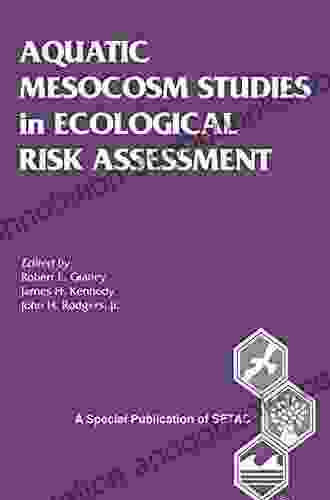Aquatic Mesocosm Studies: A Cornerstone of Ecological Risk Assessment

Aquatic ecosystems are the lifeblood of our planet, supporting an intricate web of organisms and providing essential services for human well-being. However, these ecosystems are under increasing threat from a myriad of contaminants, such as industrial chemicals, agricultural runoff, and pharmaceuticals. Accurately assessing the risks posed by these substances is crucial to safeguard the health of our aquatic resources and the communities that depend on them.
4.8 out of 5
| Language | : | English |
| File size | : | 88781 KB |
| Screen Reader | : | Supported |
| Print length | : | 736 pages |
Enter aquatic mesocosms: powerful tools that allow scientists to study ecological processes and the effects of contaminants in controlled, semi-natural environments. These mesocosms, typically ranging in size from small tanks to large outdoor ponds, provide a unique platform for investigating complex ecological interactions and predicting the long-term consequences of environmental stressors.
The Role of Aquatic Mesocosms in Ecological Risk Assessment
Ecological risk assessment (ERA) is a systematic process that evaluates the potential adverse effects of chemicals or other stressors on ecosystems. Mesocosms play a pivotal role in ERA by providing realistic, cost-effective, and scientifically defensible data to support decision-making.
Mesocosm studies can simulate various aquatic environments, including freshwater lakes, rivers, estuaries, and marine systems. Scientists can manipulate environmental variables such as temperature, light, and nutrient levels to create conditions that reflect real-world scenarios. This enables them to investigate the effects of contaminants on a wide range of organisms, from phytoplankton and zooplankton to fish and amphibians.
By conducting controlled experiments in mesocosms, researchers can determine the toxicity of contaminants, assess their fate and transport in the environment, and evaluate the potential for ecological recovery following exposure. Mesocosm studies also provide insights into the mechanisms of action of contaminants, helping scientists understand how they disrupt biological processes and ecosystem function.
Advantages of Aquatic Mesocosm Studies
- Controlled experimental conditions: Mesocosms allow scientists to isolate the effects of specific contaminants by controlling other environmental variables.
- Realistic simulations: Mesocosms provide semi-natural environments that closely resemble real aquatic ecosystems, enhancing the ecological relevance of the results.
- Long-term observations: Mesocosm studies can span weeks or even months, enabling researchers to observe chronic effects and ecosystem recovery.
- Cost-effective: Compared to large-scale field studies, mesocosm experiments offer a more cost-effective alternative for ERA.
Limitations of Aquatic Mesocosm Studies
- Scale: Mesocosms are typically smaller than natural ecosystems, which may limit their ability to capture all the complexities of real-world systems.
- Boundary effects: The enclosed nature of mesocosms can introduce artificial boundaries or edge effects that may not represent natural conditions.
- Extrapolation: Results from mesocosm studies need to be carefully interpreted and extrapolated to larger ecosystems, as they may not always be directly transferable.
Future Prospects: Advancing Mesocosm Technology
As technology continues to advance, the future of aquatic mesocosm studies is bright. Innovations in mesocosm design, instrumentation, and data analysis techniques are enhancing the accuracy and precision of ERA. Here are some promising avenues for future development:
- Automated monitoring systems: Real-time sensors and data loggers can collect vast amounts of data on environmental variables and organismal responses, enabling more comprehensive monitoring.
- Multi-trophic level mesocosms: Mesocosms that incorporate multiple trophic levels, from primary producers to top predators, can provide a more holistic understanding of ecosystem responses to contaminants.
- Linked mesocosm systems: Connecting multiple mesocosms with different exposure scenarios allows scientists to investigate cumulative effects and ecosystem resilience.
- Virtual mesocosms: Computer simulations and mathematical models can complement experimental mesocosm studies, providing additional insights and predicting long-term outcomes.
Aquatic mesocosms have emerged as indispensable tools in ecological risk assessment, providing a bridge between laboratory experiments and large-scale field studies. By simulating realistic aquatic environments, mesocosms enable scientists to unravel the complex interactions between contaminants and ecosystems, leading to better decision-making for environmental protection. As mesocosm technology continues to evolve, the future holds exciting possibilities for advancing our understanding of the intricate web of life in aquatic ecosystems.
4.8 out of 5
| Language | : | English |
| File size | : | 88781 KB |
| Screen Reader | : | Supported |
| Print length | : | 736 pages |
Do you want to contribute by writing guest posts on this blog?
Please contact us and send us a resume of previous articles that you have written.
 Book
Book Novel
Novel Page
Page Chapter
Chapter Text
Text Story
Story Genre
Genre Reader
Reader Library
Library Paperback
Paperback E-book
E-book Magazine
Magazine Newspaper
Newspaper Paragraph
Paragraph Sentence
Sentence Bookmark
Bookmark Shelf
Shelf Glossary
Glossary Bibliography
Bibliography Foreword
Foreword Preface
Preface Synopsis
Synopsis Annotation
Annotation Footnote
Footnote Manuscript
Manuscript Scroll
Scroll Codex
Codex Tome
Tome Bestseller
Bestseller Classics
Classics Library card
Library card Narrative
Narrative Biography
Biography Autobiography
Autobiography Memoir
Memoir Reference
Reference Encyclopedia
Encyclopedia Cheryl Douglas
Cheryl Douglas Raymond Birdsell
Raymond Birdsell Clarence G Hamilton
Clarence G Hamilton J S Wyvern
J S Wyvern Danielle Gibson
Danielle Gibson Teresa Palomo Acosta
Teresa Palomo Acosta Hazem Kandil
Hazem Kandil Rehan Hyder
Rehan Hyder Christian Davenport
Christian Davenport Clara Barton
Clara Barton Christina L Davis
Christina L Davis Elizabeth Jane Howard
Elizabeth Jane Howard Chris Cambell
Chris Cambell Craig Smith
Craig Smith Eileen Small
Eileen Small Ray Raphael
Ray Raphael Christine Mooney
Christine Mooney Lance Morcan
Lance Morcan Monique Mcdonell
Monique Mcdonell Pam Durban
Pam Durban
Light bulbAdvertise smarter! Our strategic ad space ensures maximum exposure. Reserve your spot today!

 Tennessee WilliamsDelve into the World of Motorcycle Mayhem with "Driller Dead Ringers MC"
Tennessee WilliamsDelve into the World of Motorcycle Mayhem with "Driller Dead Ringers MC" Allen ParkerFollow ·10.6k
Allen ParkerFollow ·10.6k Peter CarterFollow ·8k
Peter CarterFollow ·8k Dale MitchellFollow ·7.9k
Dale MitchellFollow ·7.9k Robert ReedFollow ·18.8k
Robert ReedFollow ·18.8k Eugene ScottFollow ·14.3k
Eugene ScottFollow ·14.3k Ron BlairFollow ·9.6k
Ron BlairFollow ·9.6k Carson BlairFollow ·19.7k
Carson BlairFollow ·19.7k Cade SimmonsFollow ·13.8k
Cade SimmonsFollow ·13.8k

 Kevin Turner
Kevin TurnerDive into the Enchanting World of "Crazy Like Fox": A...
Prepare yourself for a literary adventure...

 Ralph Waldo Emerson
Ralph Waldo EmersonUnlock the Elegance of Daffodil Lace: An Immersive Guide...
: A Tapestry of Delicate...

 Gerald Parker
Gerald ParkerNever Lose An Argument Again: 20 Powerful Techniques From...
Are you tired of losing...

 Xavier Bell
Xavier BellSeven Animal Insertions Filet Crochet Pattern: Embark on...
Welcome to the captivating...

 Eugene Powell
Eugene PowellMagomago in TDS Magomago 12: An Unforgettable Adventure...
Step into the Enchanting World of...

 Marvin Hayes
Marvin HayesSoft Felting Needle Holder Excellence In Reborn Artistry
Unveiling the Secrets of the...
4.8 out of 5
| Language | : | English |
| File size | : | 88781 KB |
| Screen Reader | : | Supported |
| Print length | : | 736 pages |










